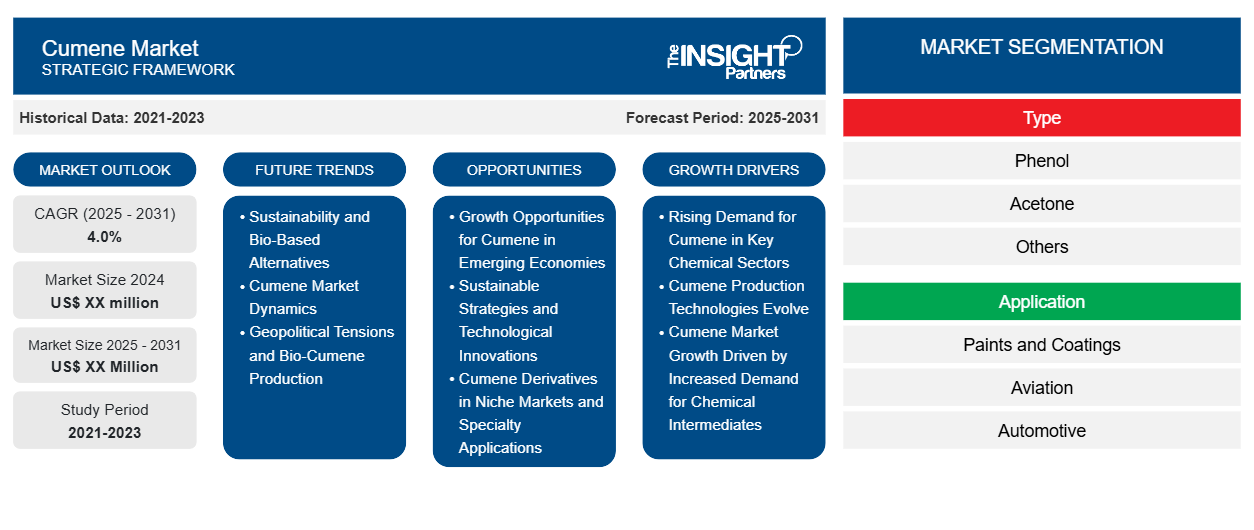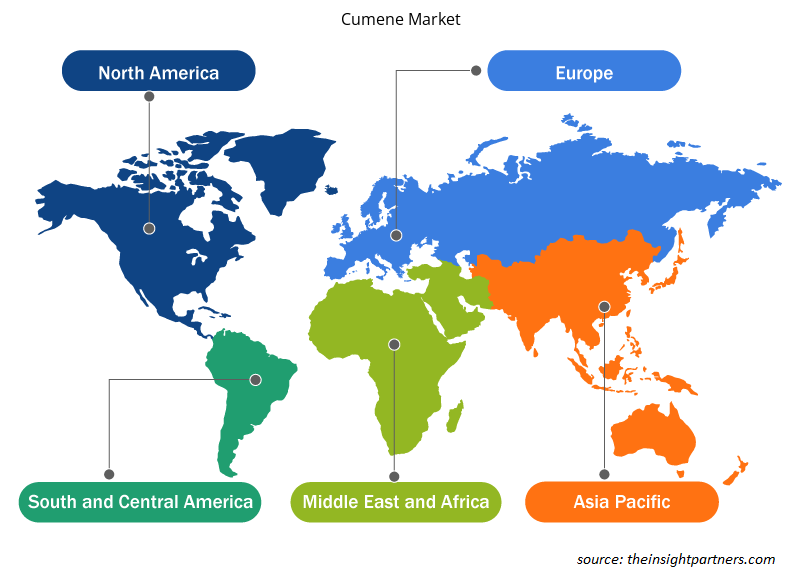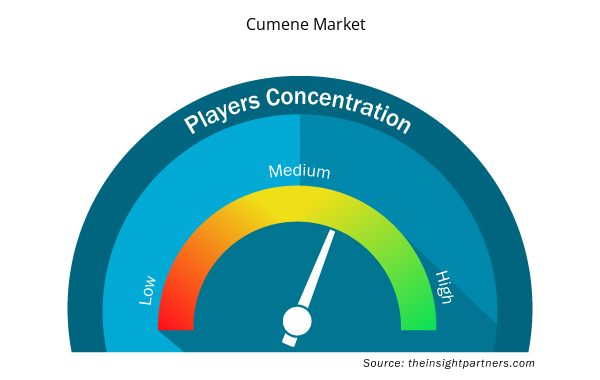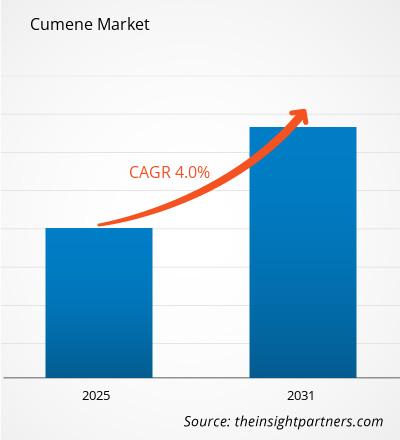Si prevede che il mercato del cumene registrerà un CAGR del 4,0% dal 2025 al 2031, con una dimensione di mercato in espansione da XX milioni di dollari USA nel 2024 a XX milioni di dollari USA entro il 2031.
Il mercato del cumene è segmentato in base a tipo, applicazione e geografia. In base al tipo, il mercato è segmentato in fenolo, acetone e altri. In base all'applicazione, il mercato è segmentato in vernici e rivestimenti, aviazione, automotive, agricoltura, tessile, trattamento delle acque e altri. L'ambito del rapporto copre cinque regioni: Nord America, Europa, Asia Pacifico, Medio Oriente e Africa, Sud e Centro America e paesi chiave in ciascuna regione. L'analisi globale è ulteriormente suddivisa a livello regionale e nei principali paesi. Il rapporto offre il valore in USD per l'analisi e i segmenti di cui sopra.
Scopo del rapporto
Il report Cumene Market di The Insight Partners mira a descrivere il panorama attuale e la crescita futura, i principali fattori trainanti, le sfide e le opportunità. Ciò fornirà spunti a vari stakeholder aziendali, come:
- Fornitori/produttori di tecnologia: per comprendere le dinamiche di mercato in evoluzione e conoscere le potenziali opportunità di crescita, consentendo loro di prendere decisioni strategiche informate.
- Investitori: condurre un'analisi completa delle tendenze relative al tasso di crescita del mercato, alle proiezioni finanziarie del mercato e alle opportunità esistenti lungo la catena del valore.
- Enti di regolamentazione: regolamentano le politiche e le attività di controllo sul mercato allo scopo di ridurre al minimo gli abusi, preservare la fiducia degli investitori e sostenere l'integrità e la stabilità del mercato.
Segmentazione del mercato del cumene
Tipo
- Fenolo
- Acetone
- Altri
Applicazione
- Vernici e rivestimenti
- Aviazione
- Automobilistico
- Agricoltura
- Tessile
- Trattamento dell'acqua
- Altri
Personalizza questo report in base alle tue esigenze
Riceverai la personalizzazione gratuita di qualsiasi report, comprese parti di questo report, o analisi a livello nazionale, pacchetto dati Excel, oltre a usufruire di grandi offerte e sconti per start-up e università
Mercato Cumene: approfondimenti strategici

- Scopri le principali tendenze di mercato in questo rapporto.Questo campione GRATUITO includerà analisi di dati che spaziano dalle tendenze di mercato alle stime e alle previsioni.
Fattori di crescita del mercato del cumene
- Domanda crescente di cumene nei settori chimici chiave: il cumene è un importante intermedio per la produzione di due principali prodotti chimici: fenolo e acetone. Questi hanno applicazioni significative nei settori della plastica, farmaceutico e altre industrie automobilistiche. Con nuove applicazioni e maggiori capacità produttive, si prevede che la domanda di cumene aumenterà in modo esponenziale.
- Le tecnologie di produzione del cumene si evolvono: l'industria chimica mondiale sta crescendo rapidamente, stimolata dalle forze dell'urbanizzazione, dell'industrializzazione e dai redditi disponibili dei consumatori più elevati. Tali risultati si traducono in una maggiore domanda di intermedi chimici come il cumene. Man mano che i paesi in via di sviluppo diventano più sofisticati, la necessità di una materia prima critica come il cumene continuerà a crescere.
- Crescita del mercato del cumene guidata da una domanda crescente di intermedi chimici: le tecnologie e i processi di produzione del cumene stanno migliorando con processi catalitici più efficienti per la produzione di cumene. Pertanto, l'output diventa più economico e migliore, rendendolo un prodotto economicamente migliore e più ecologico, stimolando ulteriormente la crescita del mercato del cumene. Un investimento in R&S, attraverso il quale le aziende migliorano la loro efficienza produttiva, darà loro un migliore vantaggio competitivo nel mercato del cumene.
Tendenze future del mercato del cumene
- Sostenibilità e alternative basate sulla biotecnologia: una strategia sostenibile ridedicata e una domanda crescente da parte di ogni settore industriale per prodotti chimici basati sulla biotecnologia adeguano i requisiti in questi mercati. Man mano che emergono più opzioni per alternative basate sulla biotecnologia, i tradizionali percorsi petrolchimici vengono sostituiti e, di conseguenza, la domanda di cumene convenzionale potrebbe cambiare. Ciò ha messo alla prova la produzione di biocumene, con l'obiettivo di portare a un processo di produzione chimica più ecologico.
- Dinamiche del mercato del cumene: innovazione, sconvolgimenti geopolitici e mutevoli strategie di produzione: la tendenza in questo caso è che, mentre i produttori cumulativi stanno allineando le loro strategie di produzione per soddisfare le esigenze di importanti utenti finali come l'automobile e l'elettronica, una crescente enfasi sui materiali leggeri e sulle tecniche di produzione avanzate stimolerebbe le innovazioni nei derivati del cumene, aprirebbe nuove strade per le applicazioni e stimolerebbe la domanda.
- Tensioni geopolitiche e produzione di bio-cumene: la recente situazione geopolitica ha creato tensioni in tutto il mondo, influenzando significativamente le catene di fornitura a causa delle interruzioni nella produzione di materie prime. Le aziende stanno, quindi, optando per fonti diverse e stanno creando strutture di produzione locali per ridurre i rischi e aumentare la resilienza. Lo scenario geopolitico e le dinamiche interrotte della catena di fornitura globale hanno quindi influenzato la strategia di mercato e i quadri operativi nel mercato del cumene.
Opportunità di mercato del cumene
- Opportunità di crescita per il cumene nelle economie emergenti: le economie emergenti nelle regioni Asia-Pacifico e America Latina si stanno rapidamente industrializzando e urbanizzando, il che offre un'enorme opportunità di crescita per il mercato del cumene. L'aumento dello sviluppo delle infrastrutture e l'aumento dei redditi disponibili hanno generato una domanda di prodotti chimici nell'edilizia, nell'automotive e nei beni di consumo, il che fa ben sperare per i produttori di cumene.
- Strategie sostenibili e innovazioni tecnologiche: le aziende saranno in grado di investire in nuove tecnologie nella produzione, ovvero aumentare il volume di produzione riducendo al minimo l'impatto sull'ambiente. La diversificazione nell'input di materie prime alternative e i miglioramenti delle operazioni catalitiche sono quindi necessari come modo per diventare leader nella produzione chimica sostenibile, soprattutto con consumatori e agenzie di regolamentazione sensibili all'ambiente.
- Derivati del cumene in mercati di nicchia e applicazioni speciali: la domanda crescente di prodotti chimici speciali in aree di mercato di nicchia offre spazio ai derivati del cumene. Sviluppando prodotti di nicchia per applicazioni distinte, i produttori di cumene possono rivolgersi a settori come l'agricoltura e la farmaceutica, nonché a segmenti di applicazioni per la cura della persona, il che aiuta a potenziare altri segmenti di crescita ad alto margine.
Approfondimenti regionali sul mercato del Cumene
Le tendenze regionali e i fattori che influenzano il Cumene Market durante il periodo di previsione sono stati ampiamente spiegati dagli analisti di Insight Partners. Questa sezione discute anche i segmenti e la geografia del Cumene Market in Nord America, Europa, Asia Pacifico, Medio Oriente e Africa, e Sud e Centro America.

- Ottieni i dati specifici regionali per il mercato del cumene
Ambito del rapporto di mercato del cumene
| Attributo del report | Dettagli |
|---|---|
| Dimensioni del mercato nel 2024 | XX milioni di dollari USA |
| Dimensioni del mercato entro il 2031 | XX milioni di dollari USA |
| CAGR globale (2025 - 2031) | 4,0% |
| Dati storici | 2021-2023 |
| Periodo di previsione | 2025-2031 |
| Segmenti coperti | Per tipo
|
| Regioni e Paesi coperti | America del Nord
|
| Leader di mercato e profili aziendali chiave |
|
Densità degli attori del mercato Cumene: comprendere il suo impatto sulle dinamiche aziendali
Il mercato del Cumene Market sta crescendo rapidamente, spinto dalla crescente domanda degli utenti finali dovuta a fattori quali l'evoluzione delle preferenze dei consumatori, i progressi tecnologici e una maggiore consapevolezza dei benefici del prodotto. Con l'aumento della domanda, le aziende stanno ampliando le loro offerte, innovando per soddisfare le esigenze dei consumatori e capitalizzando sulle tendenze emergenti, il che alimenta ulteriormente la crescita del mercato.
La densità degli operatori di mercato si riferisce alla distribuzione di aziende o società che operano in un particolare mercato o settore. Indica quanti concorrenti (operatori di mercato) sono presenti in un dato spazio di mercato in relazione alle sue dimensioni o al valore di mercato totale.
Le principali aziende che operano nel mercato del Cumene sono:
- Società Axiall
- BASF SE
- Società chimica Dow
- Società ExxonMobil
- Partecipazioni JX
Disclaimer : le aziende elencate sopra non sono classificate secondo un ordine particolare.

- Ottieni una panoramica dei principali attori del mercato Cumene
Punti di forza chiave
- Copertura completa: il rapporto copre in modo completo l'analisi dei prodotti, dei servizi, delle tipologie e degli utenti finali del mercato del cumene, fornendo una panoramica olistica.
- Analisi degli esperti: il rapporto è compilato sulla base della conoscenza approfondita di esperti e analisti del settore.
- Informazioni aggiornate: il rapporto garantisce la pertinenza aziendale grazie alla copertura di informazioni recenti e tendenze nei dati.
- Opzioni di personalizzazione: questo report può essere personalizzato per soddisfare le esigenze specifiche del cliente e adattarsi in modo appropriato alle strategie aziendali.
Il rapporto di ricerca sul Cumene Market può, quindi, aiutare a guidare il percorso di decodificazione e comprensione dello scenario del settore e delle prospettive di crescita. Sebbene possano esserci alcune preoccupazioni valide, i vantaggi complessivi di questo rapporto tendono a superare gli svantaggi.
- Analisi storica (2 anni), anno base, previsione (7 anni) con CAGR
- Analisi PEST e SWOT
- Valore/volume delle dimensioni del mercato - Globale, regionale, nazionale
- Industria e panorama competitivo
- Set di dati Excel



Report Coverage
Revenue forecast, Company Analysis, Industry landscape, Growth factors, and Trends

Segment Covered
This text is related
to segments covered.

Regional Scope
North America, Europe, Asia Pacific, Middle East & Africa, South & Central America

Country Scope
This text is related
to country scope.
Domande frequenti
Shift towards biobased chemicals is expected to be the key market trend.
On the basis of geography, the cumene market is classified into North America, Europe, Asia Pacific, Middle East and Africa, and South and Central America
The report can be delivered in PDF/Word format, we can also share excel data sheet based on request.
The major factors driving the cumene market are:
1.Growth of Chemical Industry
2. Technological Advancements
INEOS; KASEIHIN SHOJI CO., LTD.; KUMHO P and B CHEMICALS.,INC.; Santa Cruz Biotechnology, Inc.; Lummus Technology; Otto Chemie Pvt. Ltd.; KANTO KAGAKU.; Junsei Chemical Co.,Ltd.; Tokyo Chemical Industry (India) Pvt. Ltd.; Mitsubishi Chemical Corporation are some of the players operating in the market.
The Cumene Market is estimated to witness a CAGR of 4.0% from 2023 to 2031
Trends and growth analysis reports related to Chemicals and Materials : READ MORE..
1. Axiall Corporation
2. BASF SE
3. Dow Chemical Company
4. ExxonMobil Corporation
5. JX Holdings
6. LG Chem Ltd.
7. Royal Dutch Shell PLC
8. SABIC
9. Sumitomo Chemical Corporation
10. Total S.A.
The Insight Partners performs research in 4 major stages: Data Collection & Secondary Research, Primary Research, Data Analysis and Data Triangulation & Final Review.
- Data Collection and Secondary Research:
As a market research and consulting firm operating from a decade, we have published and advised several client across the globe. First step for any study will start with an assessment of currently available data and insights from existing reports. Further, historical and current market information is collected from Investor Presentations, Annual Reports, SEC Filings, etc., and other information related to company’s performance and market positioning are gathered from Paid Databases (Factiva, Hoovers, and Reuters) and various other publications available in public domain.
Several associations trade associates, technical forums, institutes, societies and organization are accessed to gain technical as well as market related insights through their publications such as research papers, blogs and press releases related to the studies are referred to get cues about the market. Further, white papers, journals, magazines, and other news articles published in last 3 years are scrutinized and analyzed to understand the current market trends.
- Primary Research:
The primarily interview analysis comprise of data obtained from industry participants interview and answers to survey questions gathered by in-house primary team.
For primary research, interviews are conducted with industry experts/CEOs/Marketing Managers/VPs/Subject Matter Experts from both demand and supply side to get a 360-degree view of the market. The primary team conducts several interviews based on the complexity of the markets to understand the various market trends and dynamics which makes research more credible and precise.
A typical research interview fulfils the following functions:
- Provides first-hand information on the market size, market trends, growth trends, competitive landscape, and outlook
- Validates and strengthens in-house secondary research findings
- Develops the analysis team’s expertise and market understanding
Primary research involves email interactions and telephone interviews for each market, category, segment, and sub-segment across geographies. The participants who typically take part in such a process include, but are not limited to:
- Industry participants: VPs, business development managers, market intelligence managers and national sales managers
- Outside experts: Valuation experts, research analysts and key opinion leaders specializing in the electronics and semiconductor industry.
Below is the breakup of our primary respondents by company, designation, and region:

Once we receive the confirmation from primary research sources or primary respondents, we finalize the base year market estimation and forecast the data as per the macroeconomic and microeconomic factors assessed during data collection.
- Data Analysis:
Once data is validated through both secondary as well as primary respondents, we finalize the market estimations by hypothesis formulation and factor analysis at regional and country level.
- Macro-Economic Factor Analysis:
We analyse macroeconomic indicators such the gross domestic product (GDP), increase in the demand for goods and services across industries, technological advancement, regional economic growth, governmental policies, the influence of COVID-19, PEST analysis, and other aspects. This analysis aids in setting benchmarks for various nations/regions and approximating market splits. Additionally, the general trend of the aforementioned components aid in determining the market's development possibilities.
- Country Level Data:
Various factors that are especially aligned to the country are taken into account to determine the market size for a certain area and country, including the presence of vendors, such as headquarters and offices, the country's GDP, demand patterns, and industry growth. To comprehend the market dynamics for the nation, a number of growth variables, inhibitors, application areas, and current market trends are researched. The aforementioned elements aid in determining the country's overall market's growth potential.
- Company Profile:
The “Table of Contents” is formulated by listing and analyzing more than 25 - 30 companies operating in the market ecosystem across geographies. However, we profile only 10 companies as a standard practice in our syndicate reports. These 10 companies comprise leading, emerging, and regional players. Nonetheless, our analysis is not restricted to the 10 listed companies, we also analyze other companies present in the market to develop a holistic view and understand the prevailing trends. The “Company Profiles” section in the report covers key facts, business description, products & services, financial information, SWOT analysis, and key developments. The financial information presented is extracted from the annual reports and official documents of the publicly listed companies. Upon collecting the information for the sections of respective companies, we verify them via various primary sources and then compile the data in respective company profiles. The company level information helps us in deriving the base number as well as in forecasting the market size.
- Developing Base Number:
Aggregation of sales statistics (2020-2022) and macro-economic factor, and other secondary and primary research insights are utilized to arrive at base number and related market shares for 2022. The data gaps are identified in this step and relevant market data is analyzed, collected from paid primary interviews or databases. On finalizing the base year market size, forecasts are developed on the basis of macro-economic, industry and market growth factors and company level analysis.
- Data Triangulation and Final Review:
The market findings and base year market size calculations are validated from supply as well as demand side. Demand side validations are based on macro-economic factor analysis and benchmarks for respective regions and countries. In case of supply side validations, revenues of major companies are estimated (in case not available) based on industry benchmark, approximate number of employees, product portfolio, and primary interviews revenues are gathered. Further revenue from target product/service segment is assessed to avoid overshooting of market statistics. In case of heavy deviations between supply and demand side values, all thes steps are repeated to achieve synchronization.
We follow an iterative model, wherein we share our research findings with Subject Matter Experts (SME’s) and Key Opinion Leaders (KOLs) until consensus view of the market is not formulated – this model negates any drastic deviation in the opinions of experts. Only validated and universally acceptable research findings are quoted in our reports.
We have important check points that we use to validate our research findings – which we call – data triangulation, where we validate the information, we generate from secondary sources with primary interviews and then we re-validate with our internal data bases and Subject matter experts. This comprehensive model enables us to deliver high quality, reliable data in shortest possible time.

 Ottieni un campione gratuito per questo repot
Ottieni un campione gratuito per questo repot